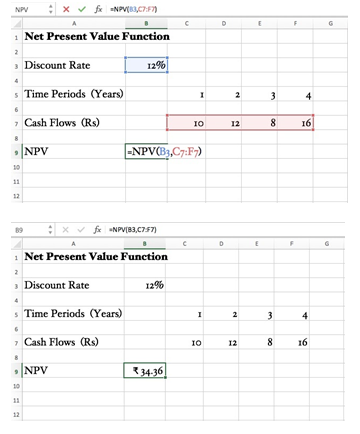Contents
Introduction
Money in the present is worth more than the same amount in the future due to factors like inflation and opportunity cost. A rupee earned in the future won't be worth as much as one earned in the present. This is the premise behind the principles of discounting and the time value of money.
In order to make investment decisions, or to choose an alternative amongst many others, organizations and individuals have to consider the present worth of expected future returns after discounting it. This is in essence, a function of capital budgeting, and there is a tool to do the same — Net Present Value Formula.
Read about other Capital Budgeting Techniques Here
Net present value (NPV) is the difference between the present value of cash inflows and the present value of cash inflows and the present value of cash outflows over a period of time.
The concept can be understood as:
NPV = TVECF - TVIC
Where :
- TVECF = Today's Value of the Expected Cash Flows
- TVIC = Today's Value of Invested Cash

NPV Formula
The Net Present Value can be calculated for a single cash flow or a series of cash flows based on a specified discount rate. The Net Present Value formula is :
NPV = (Cash flows) / (1+r) t
- Cash Flows = Cash Flows in the Time Period
- r = Discount Rate
- t = Time Period
Cash flows are discounted over the different periods and then the initial investment is deducted from it. If the result is a positive value, the project may be accepted. If the result is a negative figure, then it implies that the project cannot cover its cost of completion.
Example
Let's assume X Ltd wants to invest Rs 100,000 in a project. The projected returns are Rs. 20,000 in the first year, Rs 35,000 in the second year, Rs 55,000 in the third year, Rs 68,000 in the fourth year, and Rs 70,000 in the fifth year. Assuming the discount rate to be 12%, calculate NPV.
|
Year |
Cash Flow |
Discounting |
Present Value |
|
0 |
(1,00,000) |
(1,00,000) |
|
|
1 |
20,000 |
20,000 / 1.12 |
17,857.14 |
|
2 |
35,000 |
35,000 / (1.12)2 |
27,901.77 |
|
3 |
55,000 |
55,000 / (1.12)3 |
39,147.91 |
|
4 |
68,000 |
68,000 / (1.12)4 |
43,215.23 |
|
5 |
70,000 |
70,000 / (1.12)5 |
39,719.88 |
|
Net Present Value |
167841.93 |
||
Since the NPV is positive the investment is profitable and hence X Ltd can go ahead with the expansion.
To calculate the NPV of the money you hold, try CAClubIndia NPV Calculator
Merits of NPV Method
- It accounts for the time value of money. It estimates wealth creation from potential investment in today's Rupee value, given the applied discount rate.
- It is straightforward to calculate and can be directly applied in excel. This will be discussed further in the article.
- It uses cash flows rather than net earnings (which includes non-cash items such as depreciation). This gives a more realistic picture of returns on investment.
- It is an additive. You can add up NPVs of projects to get a sense of aggregate wealth creation from all investable projects.
Limitations of the NPV Method
- The discount rate selected may be arbitrary. If a higher rate of return is assumed, it can show a false negative NPV. If a lower rate of return is taken it will show the false profitability of the project.
- It also assumes the discount rate is the same over the life of the investment or project. Discount rates, like interest rates, can and do change year-to-year. Opportunity costs change and differ across investors.
- NPV assumes you can accurately assess and predict future cash flows which may not always be possible.
- It may be intuitively difficult to grasp the concept.
Calculate NPV on Excel
Net Present Value formula can also be applied in Excel to the data you are analyzing. The NPV can be computed directly. The formula to be given is :
= NPV(discount rate, series of cashflow)
An illustration of how to use the NPV function:
- Step 1 - Enter Discount Rate in a cell
- Step 2 - Enter a series of cash flows (must be in consecutive cells)
- Step 3 - Type in the formula, select the cell containing discount rate, and then the cashflow cells. (These cells must come within the brackets)

For More Reading: IRR or NPV | Which one is the best in financial management?







 CAclubindia
CAclubindia
